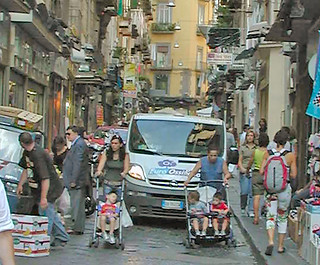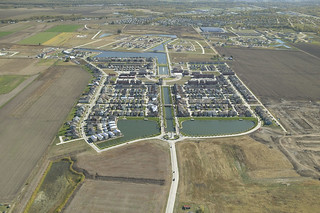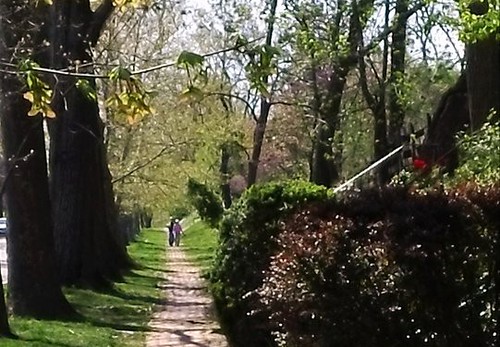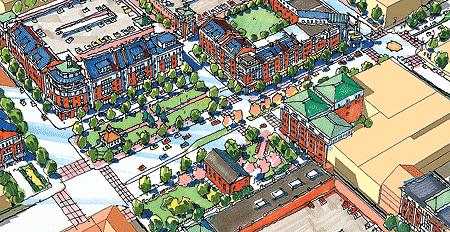Cities, sustainable placemaking, & the careful use of words

Posted September 5, 2012 at 1:24PM
I’ve been clean and sober for 20 months now and still counting. Lest you think that I am about to take you down a path of Too Much Information, please join me in lifting a beverage of choice to celebrate that it has been at least that long since I last used the word “vibrant” in my writing. I won’t speak for everyone, but for me the word had become so overused in expressing what smart growth and urban advocates seek in communities that it had become annoying at best, lazy and hackneyed at worst, stripped of fresh meaning by repetition. Enough already.
But it was also more than that: I’m not even sure that “vibrancy” is always a desired outcome. Merriam-Webster defines vibrant as “(1): oscillating or pulsating rapidly (2): pulsating with life, vigor, or activity <a vibrant personality>.” While the second of those meanings certainly describes one kind of place (or person, for that matter) that can be very desirable in the right context, I don’t buy that lively places are inherently superior to calm ones as locations to live, work and visit. We should support vibrant cities and neighborhoods, yes, but we should strive to preserve and create serene ones, too.
So, for several reasons I remain done with the word. More about vocabulary in a minute but, first, a personal detour:
Acquiring fresh perspective
With today’s article, I’m coming off a three-week break from writing, the first such intermission I have taken in five years. It has felt a little weird, to be honest. I’ve actually discerned a hint of what people may mean when they speak of this phenomenon called “free time.” But I have needed the break, because my almost-daily writing was feeling a bit routine, a bit of a chore, and that’s not what I want: quite beyond the lazy overuse of any one word, the last thing I want is for this space to become repetitive or predictable.
because my almost-daily writing was feeling a bit routine, a bit of a chore, and that’s not what I want: quite beyond the lazy overuse of any one word, the last thing I want is for this space to become repetitive or predictable.
I don’t want just to advocate, to promote ideas that are already part of established agendas. Instead, I want to probe and explore, to challenge and stretch my own thinking along with that of my readers. I’ve expressed before my concern that advocacy in the world of placemaking and smart growth has become a bit stale, a bit 20th-century, (more than) a bit too reluctant to admit mistakes or uncertainties, to absorb new knowledge, and to evolve with experience.
Indeed, a reluctance to admit mistakes and uncertainties is built into the job of advocacy if one doesn’t guard against it: conventional approaches, especially in the worlds of law and policy, tend to encourage advocates to act 100 percent certain about things we frequently have reason to be less than 100 percent certain about. That doesn’t mean that being 70 or 80 percent confident about something isn’t ever good enough to justify a definite point of view, but I believe that those of us in the business of trying to make the world a better place should be not just advocates but also thinkers and truth-seekers. It is important to acknowledge and honor that 20 or 30 (or whatever) percent of doubt.
The hazards of “urbanism”
If you're still with me, thanks for tolerating that bit of self-indulgence. Now, back to vocabulary: as a lover of words and language, I am always thinking about their meaning and best use. And I now believe it may be time to send “urbanism” to the same literary retirement as “vibrant.” To readers who come from the environmental world, it may seem a bit strange to question a term than no one in that world ever uses in the first place. But I also have a foot in the realm of city planning and architecture, where it has a great deal of currency. The goal of avoiding the word may prove a challenge: a search of my archives reveals that I have used “urbanism” or “urbanist” in over 300 previous blog entries  (“vibrant” clocked in at 51, if you’re wondering). I may not be able to swear off its use altogether.
(“vibrant” clocked in at 51, if you’re wondering). I may not be able to swear off its use altogether.
While I am definitely pro-city, my first problem with urbanism is that in some circles it has taken on the air of a cult, providing a verbal badge of identification. The word carries an assumption not just that adherents love and promote cities but also subscribe to a growing code of written and unwritten precepts and rules about how our built environment should be organized – starting but not ending with density, gridded streets, mixed uses, priority to pedestrians rather than drivers, and so on. The details can get pretty elaborate. Although, in any given situation, I probably subscribe to at least 80 percent of those rules, and to a much higher percentage of the most basic ones, I don’t want to be defined by them. I would rather discuss what makes a particular solution appropriate to a particular situation than apply a formula; I would rather articulate and include the 20 percent or so of deviation, if you will, in my thinking and writing. I also believe that, just as the principles of smart growth have gotten stale, so have the overlapping principles of urbanism. Overly familiar vocabulary can lead to overly familiar thinking.
(I should interject here that the Congress for the New Urbanism, of which I have been a member for going on 15 years, as well as an occasional volunteer and partner, has an elaborate set of principles defining what good urbanism is, starting with a brilliantly conceived founding charter. I won’t discuss here all the subsequent expositions of "the" new urbanism, but that charter – about as long as this blog post – remains perhaps the most articulate statement I have seen to date describing how the built environment can be organized to support sustainability. I’m in, and my career would not be the same without the many lessons I have absorbed from CNU and its practitioners. But the charter’s implementation has been messy: to the extent I have quarrels with some examples of new urbanism as actually practiced, and I certainly do, it is not with the ideals in that initial document but with the occasional distortion of those ideals in the real world of money and opportunity. New urbanism can also be incomplete as a system, placing less emphasis on environmental and social values than on the physical form of settlement.)
 But perhaps an even bigger problem with “urbanism” is that the word is ridiculously overused. A lot of us have been invested in it. Indeed, a search on Amazon for books associated with urbanism now produces over two thousand titles. It comes in a bewildering variety of forms – old, new, sustainable, tactical, landscape, pop-up, accidental, adaptive, emergent, Latino, recombinant, magical, integral, green, military, "true," everyday, postmodern, guerilla, mobile, even an oxymoronic “agrarian” strain, and more. Various versions of the label are used to justify everything from illegally spray-painting public property to development in places that no sensible person would honestly consider “urban” unless they have drunk gallons of metaphorical Kool-Aid. I could define urbanism in my own way and probably be perfectly comfortable with the result. But communication is about using words in ways that are not just personal but understood in common, and this one has now splattered all over the map, including in ways that I find troubling.
But perhaps an even bigger problem with “urbanism” is that the word is ridiculously overused. A lot of us have been invested in it. Indeed, a search on Amazon for books associated with urbanism now produces over two thousand titles. It comes in a bewildering variety of forms – old, new, sustainable, tactical, landscape, pop-up, accidental, adaptive, emergent, Latino, recombinant, magical, integral, green, military, "true," everyday, postmodern, guerilla, mobile, even an oxymoronic “agrarian” strain, and more. Various versions of the label are used to justify everything from illegally spray-painting public property to development in places that no sensible person would honestly consider “urban” unless they have drunk gallons of metaphorical Kool-Aid. I could define urbanism in my own way and probably be perfectly comfortable with the result. But communication is about using words in ways that are not just personal but understood in common, and this one has now splattered all over the map, including in ways that I find troubling.
Other “isms” and my hopes for this blog
I should add that I’m not really thrilled with “environmentalism,” either, for similar reasons. There’s no way I would be in my line of work if I didn’t believe in respecting nature and the bundle of values that we associate with “the environment.” But that doesn’t mean that I think the strongest course of action to protect the environment is easy to define – indeed, sometimes protecting one aspect of the environment means allowing some impact to another – or should always trump other values.
I want this blog – this is post number 1,125 – to be not about advocating any script or preset system of belief but instead about thought, the pursuit of truth and, yes, sometimes about finding a balance among the various competing interests – planetary health, local environmental health, individual aspirations, community, solitude, economy, equity, the whole messy gumbo –  that, pretend as we may, cannot always be aligned when it comes to cities, neighborhoods or the environment. “Isms” of any sort can get in the way of those objectives.
that, pretend as we may, cannot always be aligned when it comes to cities, neighborhoods or the environment. “Isms” of any sort can get in the way of those objectives.
When I first joined NRDC 31 years ago, I considered myself lucky just to have a job that allowed me to advocate “the environmental point of view.” Now, though, I feel more responsibility, including a duty to consider, shape and, yes, even question what that point of view should be.
I also want this blog to be about humor, discovery and the celebration of great work and provocative new approaches to challenges. It will certainly continue to be about images as much as words – that makes for twice as much work, but it’s how I like to communicate. (By the way, if you aren’t reading this on my home blog site, you may not be seeing all the images I select to illustrate a given article, and you may be seeing a different headline than I would choose. Other sites exercise their own editorial judgment.)
And, frankly, sometimes my writing will just be about a whim that interests me and that I hope will interest you. I can’t thank my readers enough for supporting my work and engaging in dialogue on how to keep improving our cities, towns, regions and neighborhoods. Not to mention all the writers and thinkers whose work inspires and teaches me – there are many. On some level, this is about keeping a broad conversation going and helping each other figure out the solutions to the puzzle. Let’s keep at it.
Oh – one more thing: for the record, I’m about 80 percent confident in what I wrote above. See you next time.
Related posts:
- Is placemaking a "new environmentalism"? (April 23, 2012)
- Understanding urbanism, from a Christian theologian (March 29, 2011)
- How much urbanism is enough? (January 13, 2011)
- The “essence of urbanism" (December 21, 2010)
- 'Agricultural urbanism' that actually is urban (July 6, 2010)
- Faith-based environmentalism: an interview with Michael Abbaté (Part 1) (May 19, 2009)
- Positive energy + bikes + art = vibrant community in E-Ho, LA (March 11, 2009)
Move your cursor over the images for credit information.

